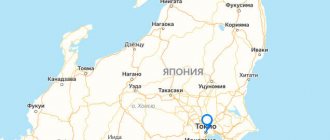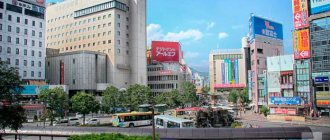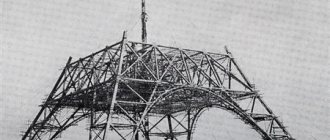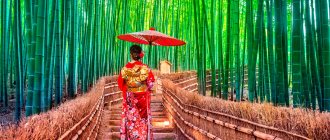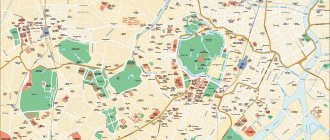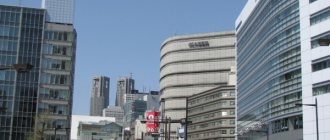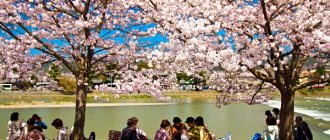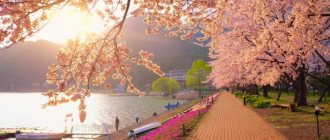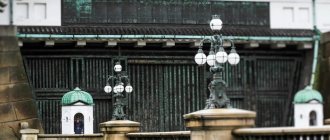Author:
Galina
14:51 | 14.01.2017
Heading:
Japan
700
400
When planning a trip, rational people try to find out as much as possible about the destination in order to take the necessary things and not get caught in the rain or hurricanes. The weather in Tokyo is not always pleasant for tourists. There are rainy and cold periods here. The city is located in the subtropical zone. Additionally, it is “warmed” by the ocean, softening the weather compared to mainland territories at the same latitude.
General climatic conditions
The capital of Japan is located on the ocean, in the area of the warm Kuroshio Current. This causes increased climate humidity. The driest months are January and February. They are also the coldest. The climate in this area can be compared with the Black Sea coast of the Caucasus or Crimea. Temperatures rarely drop below zero. Although there is snow in Tokyo too. As a rule, it pleases the local population once a year.
This region has two rainy seasons. The first one falls at the beginning of summer. Approximately it runs from the first of June and ends in the second ten days of July. The Japanese joke that at this time people walk and swim at the same time. The second half of this month and the whole of August is a time of heat. It is preferred by many tourists to visit local attractions. The second wet season begins in September. According to official data, June and the first month of autumn have the fewest hours of sunshine (120 and 113, respectively).
Big anthill
Tokyo is a city that is often called the “big anthill”. The fact is that thousands of houses, buildings and structures were erected here along the narrow streets. Two cars can barely pass each other in most of them. Neighborhoods with large shopping centers and skyscrapers stand in stark contrast. Among other things, the metropolis is shrouded in a network of wires, rails and roads. If on its main streets there are mainly buildings erected in the European style, then on the more distant ones there are densely built, mostly two-story houses.
The Japanese are trying to make the most of every piece of land in Tokyo. The prices for it here are simply astronomical. The main reason for this is due to the acute lack of free space. As a result, the country's government is forced to gradually fill up the sea. In this way, artificial islands are created, on which not only residential areas are built, but even airports, factories, shopping centers, parks and other objects. According to rough estimates, by the end of 2015 the population in the Tokyo metropolitan area will reach 29 million people.
Typhoons in Tokyo
Japan is a country that has a rather unpleasant reputation. Information about earthquakes and typhoons is etched into human memory because of the huge number of casualties caused by such disasters. However, such events are rare. The coast of Tokyo is indeed sometimes subject to typhoon attacks. The last serious hurricane in the region was in 1991. It can be considered that serious winds are rare for a metropolis. Ordinary subtropical typhoons bring rain to the city. As a rule, this occurs in September and early spring.
Interesting Facts
- If Tokyo were a separate country, it would rank 15th in the world in the list of countries by GDP.
- An asteroid that was discovered by local astronomers in 1900 is named after the Japanese capital.
- Tokyo is the city where about 35% of higher education institutions in Japan are concentrated. Every second student in the country studies there.
- Due to high seismic activity in the region, discussions often arise in the state regarding the possibility of moving the capital to another city. The main contenders are Higashino, Nasu and Mie. Despite the government's approval of this idea, no further action has yet been taken.
- For 14 years in a row, until 2006, the famous publication The Economist named Tokyo the most expensive city on the planet in terms of cost of living and real estate.
Hot Summer
The climate of the metropolis differs from the general climate in the country. Scientists have found that the average daily temperature is influenced by buildings and communications, and people’s behavior also makes its contribution. Thus, in Tokyo this figure is 4 degrees higher than in the rest of the region. Summer in the capital is long and stuffy, if you do not take into account the humid season. It ends almost in November. Spring doesn't come all at once either. All its signs can clearly be seen only in early May.
The heat in Tokyo is different from what residents of the continent are used to. It is wet, which makes it more difficult to bear. People find it difficult to breathe, have no appetite, and no desire to move. You need to get used to this season so as not to suffer from the stuffy, sweltering heat. The Japanese and tourists resort to green tea or fruit water; a favorite summer treat is kakigori. It is advisable to keep and consume drinks chilled.
Light clothing is encouraged to help cool the body. Public areas are usually equipped with air conditioning. In the summer, the Cool Biz campaign begins at enterprises and organizations, which, on the one hand, allows workers to endure the heat more easily, and on the other hand, use air conditioners less often. This is done in order to save electricity, the supply of which is limited in Japan, and to reduce the negative impact of air conditioners on the environment.
The crowd of people in the metropolis makes the heat worse. Roads and buildings absorb heat from the sun's rays and prevent people from resting at night. They release the accumulated heat to the surrounding space. Scientists have noticed that the average daily temperature rises by half a degree every year. People on city streets are increasingly suffering from heatstroke. By the way, the operation of a large number of air conditioners also does not contribute to the coolness outside the windows of the rooms in which they refresh the air.
Local residents are used to the sweltering season. They protect themselves with traditional green tea and comfortable clothes. During hot weather, handkerchiefs and napkins are sold everywhere to wipe away sweat. Interestingly, there are no deodorants in Japan.
No, after all, there are deodorants, but not quite in the form that is familiar to us, although the classic ones are also available for sale. The Japanese, unlike Europeans, tolerate heat more easily and practically do not sweat, so local residents do not need them, and foreigners bring these personal hygiene products from their homeland.
The Japanese government is concerned about the constant warming of the climate and, as a result, an increasing number of people suffering from the effects of heat. A temperature of 35° no longer surprises anyone. Combined with high humidity, this is an explosive mixture for the human body. The risk group consists mainly of children and the elderly.
Moreover, on the eve of the 2021 Olympics, the authorities are thinking about how to ensure a comfortable stay for people on the city streets and indoors. In this regard, new technologies and systems are being developed. In 2021, islands of fresh and cool air, developed by Panasonic, were installed in Tokyo; climate and cooling are created using environmentally friendly air conditioning.
Construction of the city
Over the course of several centuries, various rulers tried to gain control of the fort. Only in 1457 was Edo Castle built here, owned by Ota Dokan, who ruled the Kanto areas. For more than a hundred years, the building belonged to his clan.
In 1590, the Tokugawa ruler attacked the castle and captured it. Since the structure had an advantageous location, Tokugawa settled in it and made it the capital of his shogunate. However, the national capital was still the city of Kyoto.
The development of the castle continued, and the city gradually began to grow around it, accepting more and more inhabitants within its walls. Control of the bay gave access to water, fish and other marine resources that allowed them to live comfortably.
Moat and walls surrounding Edo Castle
Very quickly, the city of Edo became famous not only in Japan, but also in the world, and was one of the most developed.
Interesting: Why is pasta called pasta?
Best time to visit Tokyo
As they say, there is no arguing about tastes. But hardly anyone would like to run around the city in pouring rain. The best months to visit the capital of Japan are considered to be from March to May and from October to December. During these periods there is little precipitation and gentle temperatures. Moreover, the Japanese themselves say that it is better to come at the end of March and not plan to stay here longer than the first ten days of December. Otherwise you may end up in the cold. Please note that there is no central heating in the country!
Let's look at the merits of the seasons by month. In spring it is not yet hot, there is little rainfall. But the cherry blossoms are in bloom, and the gentle breeze from the ocean pleasantly invigorates. Snow-white petals swirl in the air like snowflakes until mid-April. Tokyo has many sunny days, delighting tourists and allowing them to admire local attractions. The Japanese also love this period.
In autumn, after the end of the rainy season, the city also becomes nice. The sweltering August heat is disappearing. The trees dress up in colorful autumn decorations. In November, sometimes the breath of winter can already be felt, but the warm weather persists for a long time. Please note that the most visited months for Tokyo are summer. There are a lot of tourists everywhere that you constantly have to deal with. This is not entirely convenient, especially in rainy times.
What is the name of the Tokyo resident?
Officially, Tokyo is not a city, but one of the prefectures, more precisely, a metropolitan area (Japanese: 都to
?), the only one in this class. Its territory, in addition to part of the island of Honshu, includes several small islands to the south, as well as the islands of Izu and Ogasawara. Tokyo County consists of 62 administrative divisions - cities, towns and rural communities. When they say “Tokyo City,” they usually mean the 23 special districts included in the metropolitan area, which from 1889 to 1943 formed the administrative unit of the city of Tokyo, and are now themselves equated in status to cities; each has its own mayor and city council.
The capital's government is headed by a popularly elected governor. The government headquarters is located in Shinjuku, which is the county seat. Tokyo is also home to the government and the Tokyo Imperial Palace (also using the obsolete name Tokyo Imperial Castle), the main residence of the Japanese emperors.
Administrative division
Tokyo includes twenty-three special wards that were part of the city until 1943, but are now separate self-governing municipalities, each with a mayor and council. In addition to these 23 municipalities, the prefecture includes 26 cities, one county and four districts (5 towns and 8 villages). The Tokyo government is headed by a popularly elected governor and city assembly. The government is headquartered in Shinjuku and governs all of Tokyo, including lakes, rivers, dams, farms, outlying islands and national parks.
23 special districts of Tokyo
Each of the 23 special districts is an independent municipal entity with its own mayor and district council. As already noted, the status of special districts is equal to that of ordinary cities, but they differ from them in that some of their administrative functions are performed by the Tokyo metropolitan government.
As of October 1, 2005, the total population of all 23 special regions was about 8.457 million people, and the population density was 13,603 people per km².
Western Tokyo
To the west of the special districts are cities. They mostly serve as bedroom communities for people working in central Tokyo, but some have their own commercial and industrial base. Together these cities are often referred to as "Western Tokyo".
Cities
List of cities in the prefecture:
In the westernmost part of the prefecture is Nishitama County, which includes the following towns and villages:
Most of this area is occupied by mountains, unsuitable for urbanization. The highest mountain in Tokyo, Mount Kumotari - 2021 m, also in the Tokyo area there are mountains: Takasu (1737 m), Odake (1266 m), and Mitake (929 m). Lake Okatuma, on the Tama River near Yamanashi Prefecture, is the largest lake in Tokyo.
Districts
There are two towns and seven villages on the islands, comprising four wards of Tokyo. Municipalities by district:
